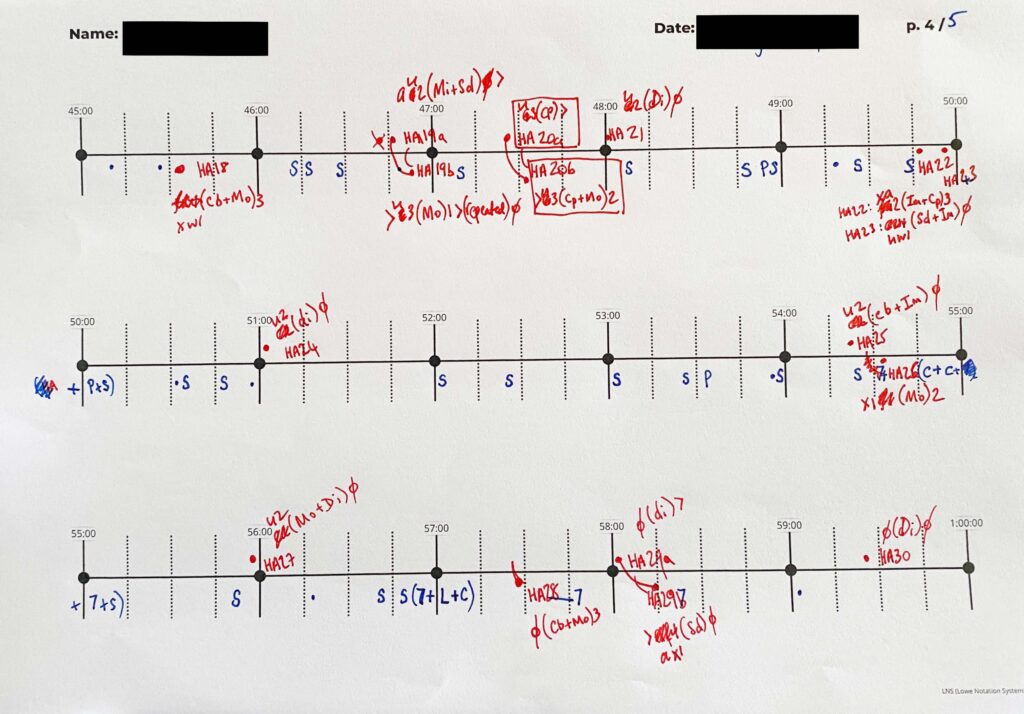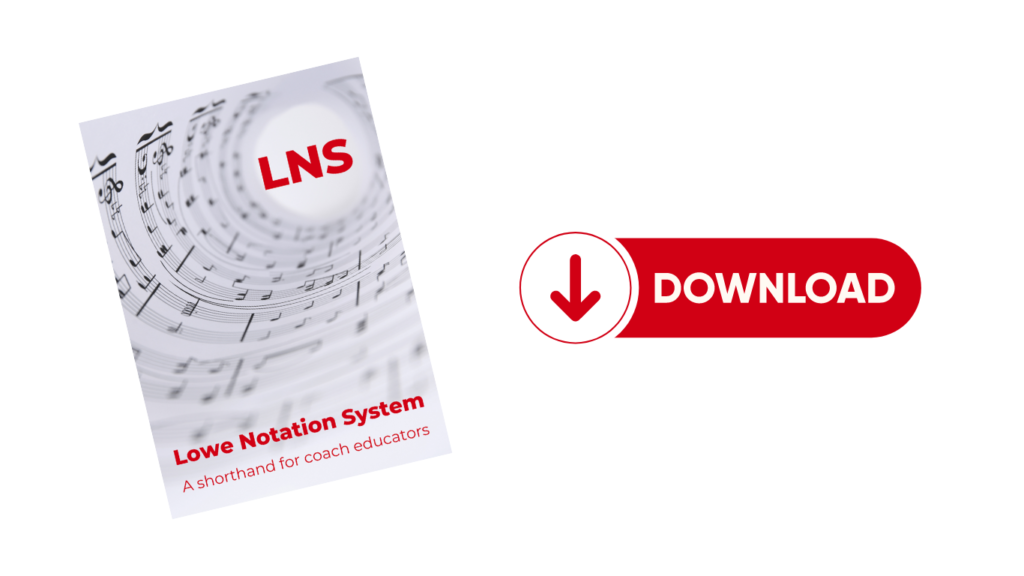LNS (Lowe Notation System)
A shorthand for coach educators
LNS is a method of visually representing the performance of a coach (both spoken and unspoken) through the use of letters, numbers and symbols. The basic notation can be augmented with detailed notes as deemed necessary by the recorder.
How it began
Originally, LNS was devised to summarise an entry-level coach’s performance during an evaluation. The initial version represented only the coach’s utterances and contained no chronological element. This was sufficient for most instances, providing a simple overview (like being given the notes from a piece of music without any other information). However, clarity around timings was sometimes useful and therefore the coaching score was introduced as an optional accompaniment.
The Coaching ‘Score’
The purpose of the ‘coaching score’ is to produce a written representation of a dyadic coaching conversation. Like a musical score, each voice is written on a separate line (the client above the horizontal line and the coach below) and the conversation is split into bars (solid vertical lines denote 60-second intervals; there may also be dotted vertical lines denoting 15-second intervals).
The coaching score was devised for doctoral research, and it is not suggested that it be used to document everyday coaching sessions.
You can download a blank coaching score below.

Lowe Notation System (LNS)
Devised primarily for evaluation purposes, the LNS visually represents the coach’s contributions (both spoken and unspoken) to the session using a combination of letters and symbols. Additional information may also be recorded by using the # symbol followed by a number which relates to a footnote.
When used with the coaching score, the LNS markers are placed below the horizontal line on the coaching score according to when they occur.
You can download a reference guide to LNS below.
| Notation | Meaning | Example |
|---|---|---|
| O | Opening question | "What would you like to talk about today?" |
| P | Powerful question | "How does that relate to your values?" |
| S | Intentional silence | Deliberately leaving silence to allow client to think. Do not score this if the client is clearly just pausing to take a breath before continuing, regardless how long the pause is. (e.g. "I think that I... [long pause]... will do xyz" does not count as a silence) |
| ns | No silence given | Firing a question straight back at the client the second they stop talking |
| C | Closed question | "Is there anything else you could do?" |
| 7 | Clarification or playback | "You said angry, upset and frustrated." (Often followed by P) |
| . | Interjection | "Hmm", "Ahh", "Uh-hu" |
| L | Overly long (usually used alongside another notation, such as P, D, C) | "What else would you like to say about the way that this has affected you and the team, etc..." |
| R | Repeat (used alongside another notation) | (P+R) would denote something like "How is that important to you? How is that important to you?" |
| # | Point of interest (followed by number, which refers to notes underneath notation) | #1 [Underneath the notation: Coach pulled face to show playfulness] |
| + | Two actions together | (P+S) would denote powerful question was followed by intentional silence |
| > | Change of one action to another | (C>P) would denote that the client started to ask a closed question but stopped and turned it into a powerful question. Such as "Is there a...What is the challenge?" |
| ec | Eye contact | Kept eye contact/was present |
| nec | No eye contact | Was not looking at client/not present |
| F | Information gathering question (that is only useful to coach) | "Who is in the room during these conversations?" |
| Y (formerly W) | Question beginning with "Why" | Why is that important to you? |
| D | Leading question | What do you think would happen if you spoke to your manager about that?" (when they hadn't mentioned talking to their manager) |
| J | Judgement / Opinion | I think that sounds like a good idea (judgement) That's just who your parents are though (opinion) |
| A | Advice | What about speaking to your manager about that? |
Humour Notation System (HNS)
The purpose of the Humour Notation System (HNS) is to represent a Humour Attempt made during a coaching session, by either the client or the coach.
Combined with the humour score and the LNS, this provides a time-based overview of a coaching session with humour used.
The HNS comprises 3 elements:
- The cue
- The HA
- The response
Elements 1 and 2 are made by the speaker; the response is made by the hearer.

An example of a score
Lorem ipsum dolor sit amet, consectetur adipiscing elit. Ut elit tellus, luctus nec ullamcorper mattis, pulvinar dapibus leo.
Text is available under the Attribution-ShareAlike licence 4.0 International (CC BY-SA 4.0)
Thanks to Rafa Ribeiro, Linda Spencer, Jane Darvill-Evans for their contributions to the system.

